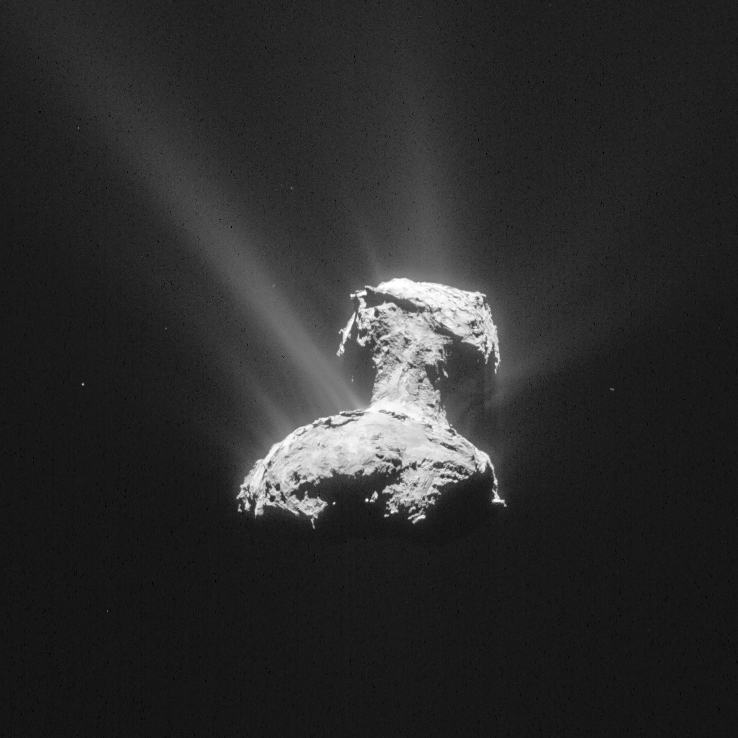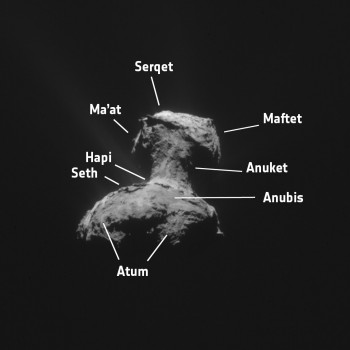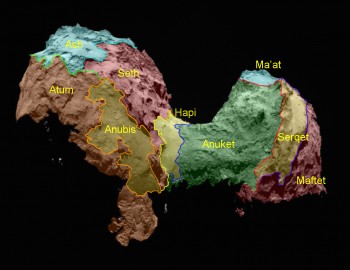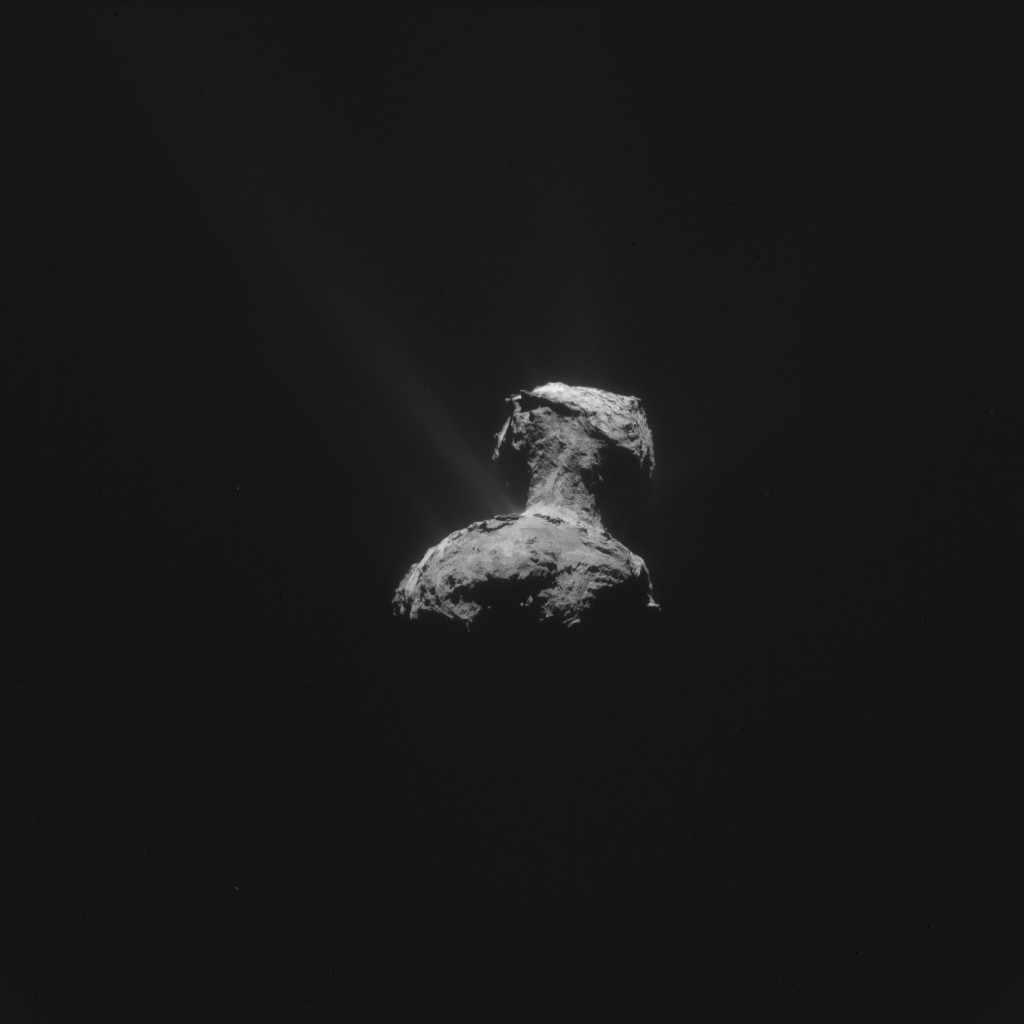Today’s CometWatch entry is another single frame NAVCAM image taken on 15 April, almost four hours after the one that was published last Friday. The new picture was obtained at about 165 km from the centre of Comet 67P/Churyumov-Gerasimenko, where the resolution of NAVCAM is 14 m/pixel. The image has been cropped and measures 10.4 km (the original frame, provided at the end of the post, measures 14.4 km across).

Cropped and processed single frame NAVCAM image of Comet 67P/C-G taken on 15 April 2015 from a distance of 165 km to the comet centre. Credits: ESA/Rosetta/NAVCAM – CC BY-SA IGO 3.0
 The image has been processed to spotlight the comet’s activity, including the striking jet on the left, in proximity of the neck region. It is interesting to compare today’s entry to CometWatch 31 January, which shows the comet in a similar orientation.
The image has been processed to spotlight the comet’s activity, including the striking jet on the left, in proximity of the neck region. It is interesting to compare today’s entry to CometWatch 31 January, which shows the comet in a similar orientation.
An annotated version of the image is provided, along with a regional map of the comet, to help identify some of the regions on 67P/C-G.
With the small lobe up and the large lobe down, today’s view showcases two of the regions on the comet’s neck, revealing the steep scarp of Anuket and the adjacent smooth Hapi region.

Regional map of Comet 67P/C-G. Credit: ESA/Rosetta/MPS for OSIRIS Team MPS/UPD/LAM/IAA/SSO/INTA/UPM/DASP/IDA
Another smooth region, Anubis, dominates the view on the large lobe, partly surrounded by the more complex terrains of Atum.
The small lobe features the sharp ridge between Serqet and Anuket and, towards the right, hints of the rough terrains of Maftet are also in sight.
The original 1024 x 1024 image is provided below:










Discussion: 30 comments
As always am amazed to see what a difference in viewpoint a few hours of rotation makes (compared to the image 4 hours earlier). I also recommend Mattias Malmer’s “Rosetta now!” image of his shapemodel where you can see this rotation over time.
It looks like chicken leg you eat. It is a chicken leg.
So every time we get a beautiful picture of these jets, someone always says something like ‘look, its obviously a discharge!’
Now I worked around discharges of many types for many years, & to me it certainly does *not*, even visually, resemble a discharge. I’ve worked on many types, many different gases, many different geometries, uA to 100’s of kA, pulsed, CW, & used all sorts of diagnostics – but in this case, I’m mainly referring to just *looking* at it. So could the ‘it looks like a discharge’ fraternity please explain:
1. Why do I see no axial variation near what we are told is the ‘cathode’, the comet? See
https://en.wikipedia.org/wiki/Glow_discharge
Near the cathode there are typically ‘dark spaces’, ‘negative glows’ etc in the axial direction; I see none; why?
2. These discharges occupy large transverse areas, many tens of square metres. But large area discharges are very prone to transverse instability – its the bane of discharge engineering for lasers & all sorts of tricks are needed to control it – & it can usually only be controlled for very short pulses (typically uS & less.) The problem, crudely, is the glow-to-arc transition, the differential negative resistance that discharges often show.
https://en.wikipedia.org/wiki/Electric_discharge_in_gases
So why does this discharge show no sign of constricting laterally when its running CW?
3.We know large volumes of gas & dust are being transported into space; one can sort of ‘see that’ too, but not quantitatively of course.
Now if its a cathode, ions are moving *towards* the cathode. What mechanism is moving vast amounts of material *away* from the comet in a ‘discharge’? Neutral collisions with ions give momentum to neutrals *towards* the comet; collisions with electrons are very ineffective at transferring momentum. Indeed we have the word ‘cataphoresis’ – and ‘electrophoresis’ but ‘anodophoresis’ doesn’t seem to exist as a term. In fact discharges *do* build up small pressure differences in say argon laser discharges – with current densities of 100’s of amps/cm^2 – But these mechanisms almost all rely on the presence of the wall of the tube. So what *exactly* is the mechanism that transports neutrals?
4. Glow discharges, generally *glow*. So I should see these things irrespective of whether they are illuminated by the sun or not. But I only see them in light scattered off dust particles. In most cases the glow has a characteristic colour given by spectral lines from electronically excited neutrals and ions. So why don’t I see this ‘glow discharge’ at all, just scattered sunlight? If its so weak I ant even see it, is that remotely consistent with it transporting massive amounts of neutrals?
Now these are just the ‘by eye’… problems…..
So please could we have actual answers to 1-4 please; if its all so obvious that should be simple enough to provide.
Hi Harvey,
By eye the sublimation theory is equally absurd (even ignoring the difficulty of seeing the surprisingly well hidden ice)
its not worth going through all the reasons why as you have above we all just go round in circles as its easy to say why not.
So if neither model works, how do we get back to basics and construct a model that we can all believe.
There are other theories and models. None of them will have all the answers, but all of them may contribute some nugget that may be proven right.
Eg. Panspermia inspired wet comet model
Stretch theory,
Living comet theory,
“It’s an alien spaceship compete with jets and thrusters” theory.
EU theory might even contribute something, once it stops pretending it has all the answers, when most of them are falsified to general satisfaction..
..
Harvey, as one of the presumed “someone”s you elegantly refer to, I’d like to record that I have sincere admiration for everything you have achieved in your illustrious career and for the brilliant manner in which you use your accumulated knowledge and experience to contribute to discussions on this forum.
I am less in agreement, however, with your basic premises. Above all, I honestly fail to understand how you can manage the intellectual contortion of simultaneously denying the obvious interpretation of the concrete optical evidence as you have done in the past (rock piles lying at the base of towering cliffs, jagged outcrops, pits, boulders and stratified formations everywhere, etc. etc.) on the grounds that *the conditions reigning on 67P are far too extreme for any Earth-like comparisons to be valid in any meaningful sense*; and at the same time of asserting that the theoretical conclusions drawn from what you, PERSONALLY, have observed many times in your OWN laboratory (I note your constant use of the personal pronoun “I”…) must necessarily be true and thus fully applicable to the extreme, little-understood conditions reigning on 67P…. The mission scientists themselves seem to rather less assertive of such certainties, starting with Holger Sierks (OSIRIS Principal Investigator) and his famous warning from several months ago, to “expect the unexpected” from the comet!
Might I humbly suggest that the laboratory up-there-in-the-sky represented by 67P is sufficiently different from your own one down-here-on-Earth for your current conclusions to be slightly premature? If we had known all along that the standard theory answers were necessarily the right ones as applied to the “extreme” conditions reigning on a comet, and that we thus had nothing new to learn, then why did we even bother to go there? In reality, the utterly unexpected nature of the acquired evidence (even that which has so far been disclosed – we can certainly “expect” far more surprises once the full data has finally been made available for wider scrutiny) fully justifies the time and money spent on the Rosetta mission. I can’t wait to see the further up-coming “surprises”.
Well said THOMAS. I would second everything except your first paragraph.
The questions Harvey illustrate your unfamiliarity with the plasma medium and your expectation that laboratory phenomena should be exactly reproduced in reality. This is rarely the case. The real situation approximates to the lab demonstration and phenomena like the various dark spaces are often fully suppressed (visually). There are numerous practical manifestations of plasma discharges, not just the laboratory bench ones you are familiar with. .
No answers.
originaljohn!
Because of Rosetta, I have renewed my space based research activities. I have been spending a considerable amount of time reading all I can on past comet missions, spectroscopy, thermodynamics, sublimation, solar system ices, and plasmas to name but six.
You write, “There are numerous practical manifestations of plasma discharges, not just the laboratory bench ones you are familiar with.”
Please enlighten. Could you cite some of the plasma physics references and research you consult to advance your understanding of comet evolution? And don’t bother with any of the Alfven (or his co-authors) literature. As a part of my early research into EU nonsense, I did work through some of his physics. There’s a reason he won a Nobel Prize. No. I want to focus on the newest ideas; say within the last five to ten years. And show no mercy with the math and modeling!
Thanks in advance, good Sir!
The only problem is, no answers to the questions.
That is certainly the problem Harvey, but its true for sublimation fans and EU fans
regards
The sublimation theory has much to explain regarding the topography etc of 67P, & the exact ‘jet’ mechanisms.
But it breaks no laws of physics, makes quantitative predictions to test, & so far, despite claims to the contrary, there is nothing to disprove it. The ‘no ice’ problem is inflated; its a very dusty comet, concentration of refractory material on the surface is unsurprising, its presence is consistent with observed degassing, broadly with the temperature; its nothing like the problem its made out to be. Whether tidal heating might be relevant is an interesting question; I’d *guess* probably not, but well worth further consideration. Oh & as I’ve said many times, I don’t exclude some *minor* role for discharges, say tribolelectric, small scale things caused by differential charging, whatever. Its a role in large scale material transport that makes no sense whatever. If Rosetta saw a ‘lightening strike’ or a little glowing patch, Id not be surprised.
Many people here clearly do not understand phenomena like choked flow & molecular flow, which tend to be outside our everyday experience, but probably are dominant on 67P.
Indeed the EU side spend their entire time attacking the sublimation theory; they never, ever provide numbers or answer direct questions like these.
In contrast to ‘convention’, there actually is no EU ‘theory’. It is just an incoherent heap of unsupported assertions. Not even at the most primitive level do we have an explanation of the ‘circuit’ that works. Never a formula or quantitative prediction. We have a magnetic field measurement ruling out significant currents; we actually have no observation *at all* supporting it, aside from a vague perceived resemblance, perceived by people who seem to have no experience of discharges. It can’t explain the water emissions, it can’t cope with the density, so fantasizes it must be wrong – but never explains how.
The amazing thing is that it persists at all. The only reason I bother refuting it is to avoid non technical people being mislead.
EU fans have more than just the odd one. 470 kg/m^3. Big problem. Show stopper. Unexplained.
Have to say I’m with Harvey on this one, though I’m not the one qualified to provide the answers. Would love to hear a response though.
Hi Harvey,
You were asking about spin rates approaching perihelion for comets in general, and the following abstract explains the spin evolution of 9P/Tempel 1. My thesis with regards to 69P is that it slows down due to stretching around Equinox, but speeds up due to asymmetrical outgassing close to perihelion. Not sure when Equinox would be for Tempel 1.
Abstract
The evolution of the spin rate of Comet 9P/Tempel 1 through two perihelion passages (in 2000 and 2005) is determined from 1922 Earth-based observations taken over a period of 13 year as part of a World-Wide observing campaign and from 2888 observations taken over a period of 50 days from the Deep Impact spacecraft. We determine the following sidereal spin rates (periods): 209.023 ± 0.025°/dy (41.335 ± 0.005 h) prior to the 2000 perihelion passage, 210.448 ± 0.016°/dy (41.055 ± 0.003 h) for the interval between the 2000 and 2005 perihelion passages, 211.856 ± 0.030°/dy (40.783 ± 0.006 h) from Deep Impact photometry just prior to the 2005 perihelion passage, and 211.625 ± 0.012°/dy (40.827 ± 0.002 h) in the interval 2006–2010 following the 2005 perihelion passage. The period decreased by 16.8 ± 0.3 min during the 2000 passage and by 13.7 ± 0.2 min during the 2005 passage suggesting a secular decrease in the net torque. The change in spin rate is asymmetric with respect to perihelion with the maximum net torque being applied on approach to perihelion. The Deep Impact data alone show that the spin rate was increasing at a rate of 0.024 ± 0.003°/dy/dy at JD2453530.60510 (i.e., 25.134 dy before impact), which provides independent confirmation of the change seen in the Earth-based observations.
We find that a net torque in the range of 0.3–2.5 × 107 kg m2 s−2 acts on the nucleus during perihelion passage. The spin rate initially slows down on approach to perihelion and then passes through a minimum. It then accelerates rapidly as it passes through perihelion eventually reaching a maximum post-perihelion. It then decreases to a stable value as the nucleus moves away from the Sun. We find that the pole direction is unlikely to precess by more than ∼1° per perihelion passage. The trend of the period with time and the fact that the modeled peak torque occurs before perihelion are in agreement with published accounts of trends in water production rate and suggests that widespread H2O out-gassing from the surface is largely responsible for the observed spin-up.
Sorry, I had trouble finding the link so I copied part of the abstract. I believe 69P should probably show a similar spin rate evolution.
Thanks for that, I’ll look it up when I have a moment.
At first sight its doesn’t seem consistent with tidal effects, but I would like to see a proper calculation done on them. Its rather off my patch so it would take me a while (& a lot of care & checking!) to be sure I believed my result.
Harvey, as you know as well as I do, from your own training, there are no possible answers to questions which are based on faulty assumptions.
In the present case, I believe the mainstream assumption that charge separation is impossible and is thus nonexistent in interplanetary, interstellar or intergalactic space is utterly wrong, since we have now acquired (via Hubble and ground-based facilities) countless numbers of images showing what can only be interpreted as Birkland currents at all scales.
Since the questions you ask and the mathematical demonstrations you make are all firmly grounded on this basic assumption which I consider to be refuted by observational evidence, they are, from my point of view (and from that of others who also believe that charge separation is the basic driving mechanism in the Universe), irrelevant and pointless. This is thus not a value judgment, it follows in all logic from my initial premise.
I have absolutely no axe to grind: I simply wish the reasons for the profound divide between mainstream and plasma cosmologies to be absolutely clear so that visitors to this blog might understand where the problem truly lies and thus form their opinions on the basis of logic, rather than being influenced by the sort of exasperation you often give way to in your use of such terms as “nonsense” when speaking of ideas and arguments which are not based on your own assumptions.
Re try.
I simply use the basic ‘laws’ of physics; which can be rigorously expressed mathematically. Something the EU community never, ever does, neither does it ever provide even the most primitive quantitative estimate of its claimed mechanisms.
Where assumptions are needed I state them – and invariably make them favourable to the opposing view.
It is trivial to demonstrate that multiple EU assertions are indeed nonsense; they do not obey the basic ‘laws’ of physics. No ‘assumptions’ are needed to do that.
Irrelevant laboratory bench questions Harvey.
Hi Claudia, H. NAVCAM Team and ESA.
We have a magneto-atmosphere. Specially that strong, near pile-up. [gyrating, breathing]. We have salts. We suspect of fluids. Do we need more to have profound heating?
Hi Claudia. “…It is interesting to compare today’s entry to CometWatch 31 January…”
4 hours lapse take us from a polyhedral body back look to a spheroidal-segment body front look.
Wanting to insist on how well the polyhedral-ism follows the layering families.
[A gem cutter knows what I’m talking about].
Speculating that spheroidal-segment body front look is due to a former huge impact, some hundred meters above actual Imhotep center.
Coraline’s neck shows a tabular form, transversal to polar axis.
https://www.esa.int/spaceinimages/Images/2015/04/Comet_on_25_March_2015_NavCam
Does the comet really rotate relative to the stars or
is that an illusion because rosetta circles around
the comet while taking pictures?
Hi Holger. The first, mostly:
https://www.esa.int/spaceinimages/Images/2015/01/Comet_vital_statistics
Have a nice day 🙂
Will you eventually be able to show an animation of the comets rotation on its axis?
It’s very important to point to the self-preserving and self-reproducing nature of ionic-fluid ‘reserves’. Once they’re there, just a few ones, just deeply enough, just big enough, They survive the ‘night’ that way, slowly transferring heat to its near surroundings, and growing in an continuously accelerated way.
A ‘critical’ condition phenomena is reached 😉
Ionic-fluids tend to go ‘under’. Following gravity, searching for gravity ‘center’, which slowly [maybe trough several perihelions] becomes a structural risk 🙂